Experiments
Contagious Urination
Researchers have uncovered the "social dimensions of urination" among captive chimpanzees. This topic had previously been "largely unexplored."They recorded urination events for a total of 604 hours and calculated urination frequency for each subject. They report:
we find that in captive chimpanzees the act of urination is socially contagious. Further, low-dominance individuals had higher rates of contagion.
I guess the obvious question is whether humans also are susceptible to contagious urination. I haven't noticed it, if we are.
More info: "Socially contagious urination in chimpanzees"
Posted By: Alex - Fri Feb 07, 2025 -
Comments (4)
Category: Animals, Experiments, Psychology, Body Fluids
Selling sad produce
In grocery stores, fresh produce such as bananas and tomatoes often goes to waste if it's become a "loose single." Shoppers think it's damaged or imperfect.German researchers have come up with a way to address this problem: make shoppers think the produce is feeling sad because it hasn't been bought.
This is achieved simply by displaying an anthropomorphized picture of sad produce above the singles.

The produce has to be sad. Happy fruits and vegetables don't motivate shoppers.
Also, making produce sad works better than offering a price discount, because shoppers often assume discounted food must be bad.
More info: Anthropomorphic Sad Expressions Reduce Waste of 'Single' Imperfect Food
via Book of Joe
Posted By: Alex - Thu Dec 12, 2024 -
Comments (2)
Category: Food, Fruit, Bananas, Advertising, Experiments, Psychology
Rat-Operated Vehicles
We've previously posted about researchers who created fish-operated vehicles.Along similar lines, neuroscientist Kelly Lambert of the University of Richmond has trained rats to drive small vehicles. She found that they were eager drivers: "the rats had an intense motivation for their driving training, often jumping into the car and revving the 'lever engine' before their vehicle hit the road."
More info: theconversation.com
"Some rats training to drive press a lever before their car is placed on the track, as if they’re eagerly anticipating the ride ahead."
Posted By: Alex - Fri Dec 06, 2024 -
Comments (1)
Category: Animals, Science, Experiments
Likelihood of Paper Cuts
A recent article in the journal Physical Review E explores what kind of paper is most likely to give you paper cuts. The answer: dot-matrix paper. Followed by magazine pages.The likelihood of cutting has to do with the thickness of the paper. Too thin and the paper buckles instead of cutting. Too thick and it indents material rather than slicing it. There's a specific range in between too thick and too thin where the paper cuts.
For the purpose of their research, the authors created a "papermachete" which they used to cut apples, bananas, chicken, etc. (see image below).
The article itself ("Competition between slicing and buckling underlies the erratic nature of paper cuts") is behind a paywall, but you can find a copy on github. One of the authors posted a video on YouTube that explains their research and findings.
More info: phys.org


Posted By: Alex - Sun Oct 27, 2024 -
Comments (1)
Category: Injuries, Science, Experiments
Rats as music critics
According to German researcher Otto Nieschulz, when rats listen to music they prefer to listen to French chansons.But when Nieschulz says 'chansons' does he mean "secular polyphonic French songs of late medieval and Renaissance music" or the "style of French pop music which emerged in the 1950s and 1960s"? According to wikipedia, both are known as chansons.
I haven't been able to track down Nieschulz's original paper, so there's no way to know. I'm guessing the rats might enjoy both.

Indianapolis Star - May 16, 1966

Victoria Times Colonist - Apr 29, 1966
Posted By: Alex - Sat Aug 31, 2024 -
Comments (1)
Category: Animals, Music, Experiments
Swallowed giraffe liver parasite
1928: Emmett Price of the US Bureau of Animal Husbandry swallowed the larvae of an unknown parasite he found in the liver of a dead giraffe. His boss explained that it was considered tradition within the parasitology section of the Bureau to self-experiment in this way.
Buffalo News - July 11, 1928

Indianapolis Star - July 2, 1928
Posted By: Alex - Tue Jul 23, 2024 -
Comments (2)
Category: Science, Experiments, 1920s
Making a dead dog bark
1909: Dr. Marage of the Paris Academy of Sciences removed the larynx from a dog and made it bark outside of its body. The larynx produced "barks and howls in every note of the canine register, from the deep baying of a mastiff to the shrill pipe of a terrier."I haven't been able to find out what Dr. Marage's first name was. All the sources I can find simply refer to him as 'Dr. Marage'.

The Sketch - Dec 15, 1909

Scientific American - Feb 5, 1910
Text from Scientific American (Feb 5, 1910):
When the larynx of a dog is removed during chloroform anesthesia, the laryngeal muscles retain their ability to contract for a short period, which varies from 3 to 10 minutes, but no contraction can be produced in the muscles of a dead larynx, even if it is removed immediately after the death of an animal, because the arterial blood has escapes.
In order to produce the vibrations, the current of air should be impelled by a pressure of from 6 to 8 inches of water, as it is in the normal production of the human voice. In these conditions the excised larynx of the dog barks and howls in every note of the canine register, from the deep baying of a mastiff to the shrill pipe of a terrier. These various notes are obtained at will by causing various muscles to contract.
Posted By: Alex - Thu Jun 20, 2024 -
Comments (0)
Category: Experiments, Dogs, 1900s
Voluntary Alcohol Consumption in Chimpanzees and Orangutans
A study published in the June 1968 issue of the Quarterly Journal of Studies on Alcohol involved giving chimpanzees and orangutans as much vodka (mixed with fruit juice) as they wanted to drink in order to find out if they'd become alcoholics.Reportedly the chimpanzees were enthusiastic drinkers and became drunk repeatedly. But oddly, the orangutans, although they drank, never showed any signs of intoxication.
I'm curious to know more details about the study, but unfortunately the article itself is locked behind a paywall.


Central New Jersey Home News - Aug 22, 1968
Posted By: Alex - Wed Jun 05, 2024 -
Comments (1)
Category: Animals, Inebriation and Intoxicants, Experiments, 1960s
Coin-Toss Experiment
Is a coin toss truly random? Not according to the "D-H-M model" which proposes that a tossed coin is slightly more likely to land on the same side that it started.To test this model, a team of researchers at the University of Amsterdam arranged for a group of subjects to flip coins a total of 350,757 times. Their conclusion: "the data reveal overwhelming statistical evidence for the presence of same-side bias."
What this means as a money-making strategy:
More info: "FAIR COINS TEND TO LAND ON THE SAME SIDE THEY STARTED: EVIDENCE FROM 350,757 FLIPS"
Posted By: Alex - Thu Apr 11, 2024 -
Comments (5)
Category: Money, Experiments
An Upside-Down Experiment
In 1950, graduate student Fred Snyder of the University of Wichita spent 30 days wearing special glasses that inverted his vision. It was part of an experiment designed by Dr. N.H. Pronko, head of the psychology department, to see if a person could adapt to seeing everything upside-down. The answer was that, yes, Snyder gradually adapted to inverted vision. And when the experiment ended he had to re-adapt to seeing the world right-side-up.Snyder and Pronko described the experiment in their 1952 book, Vision with Spatial Inversion. From the book's intro:
Such an experiment is out of the question, of course. Yet another experiment was made: a young man was persuaded to wear inverting lenses for 30 days, and his experiences are reported here. His continued progress, after an initial upset, suggests that new perceptions do develop in the same way as the original perceptions did. Life situations suggest the same thing. Dentists learn to work via a mirror in the patient's mouth until the action is automatic. In the early days of television, cameramen had to "pan" their cameras with a reversed view. Later the image in the camera was corrected to correspond with the scene being panned. The changeover caused considerable confusion to cameramen until they learned appropriate visual-motor coordinations. Fred Snyder, the subject of our upside-down experiment, found himself in a similar predicament, at least for a time.
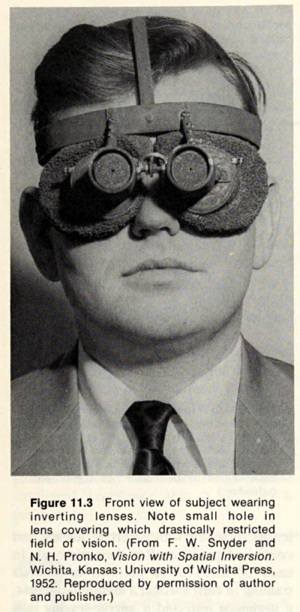
Images from Life - Sep 18, 1950:
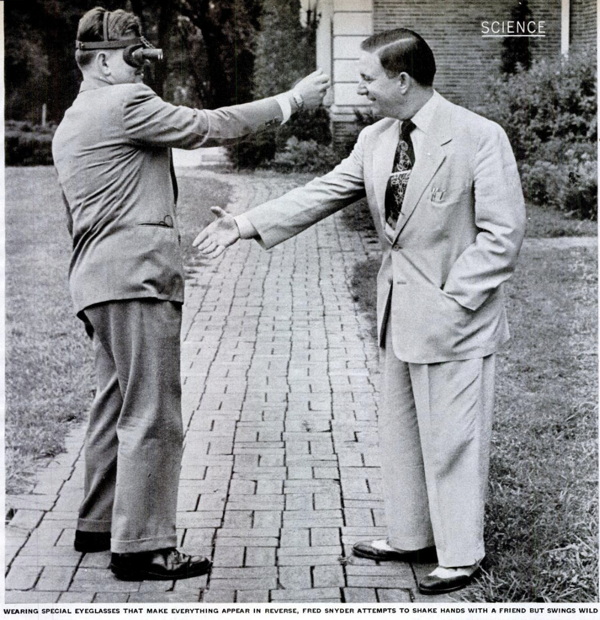
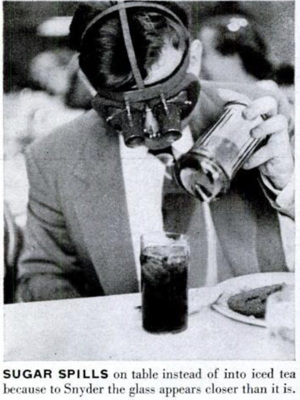
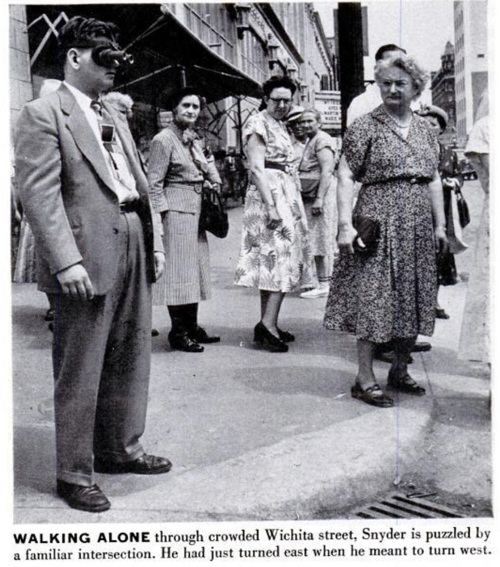
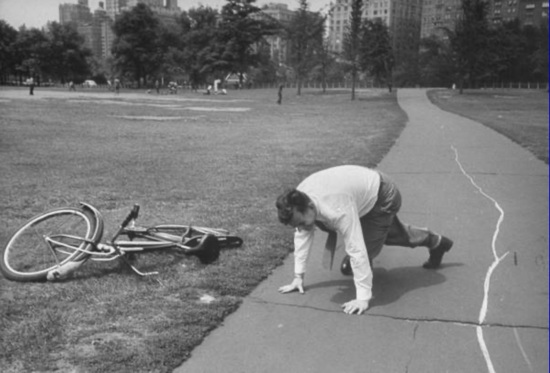
"Graduate student Fred Snyder falling down after removing special eyeglasses that reverse and invert everything he sees. Immediately before removing glasses he rode a bicycle with perfect control along sidewalk in Central Park."
Posted By: Alex - Mon Mar 25, 2024 -
Comments (2)
Category: Experiments, 1950s, Eyes and Vision

| Who We Are |
|---|
| Alex Boese Alex is the creator and curator of the Museum of Hoaxes. He's also the author of various weird, non-fiction, science-themed books such as Elephants on Acid and Psychedelic Apes. Paul Di Filippo Paul has been paid to put weird ideas into fictional form for over thirty years, in his career as a noted science fiction writer. He has recently begun blogging on many curious topics with three fellow writers at The Inferior 4+1. Contact Us |




